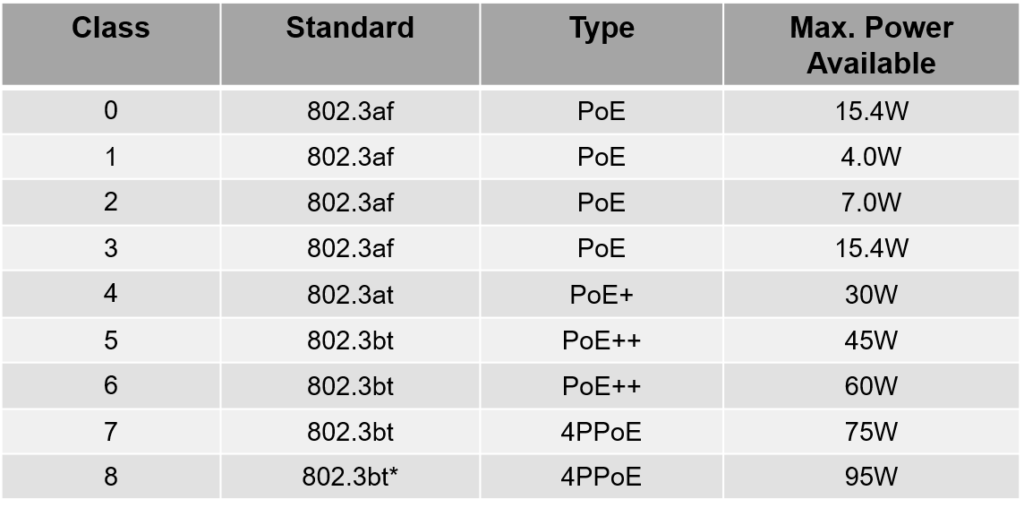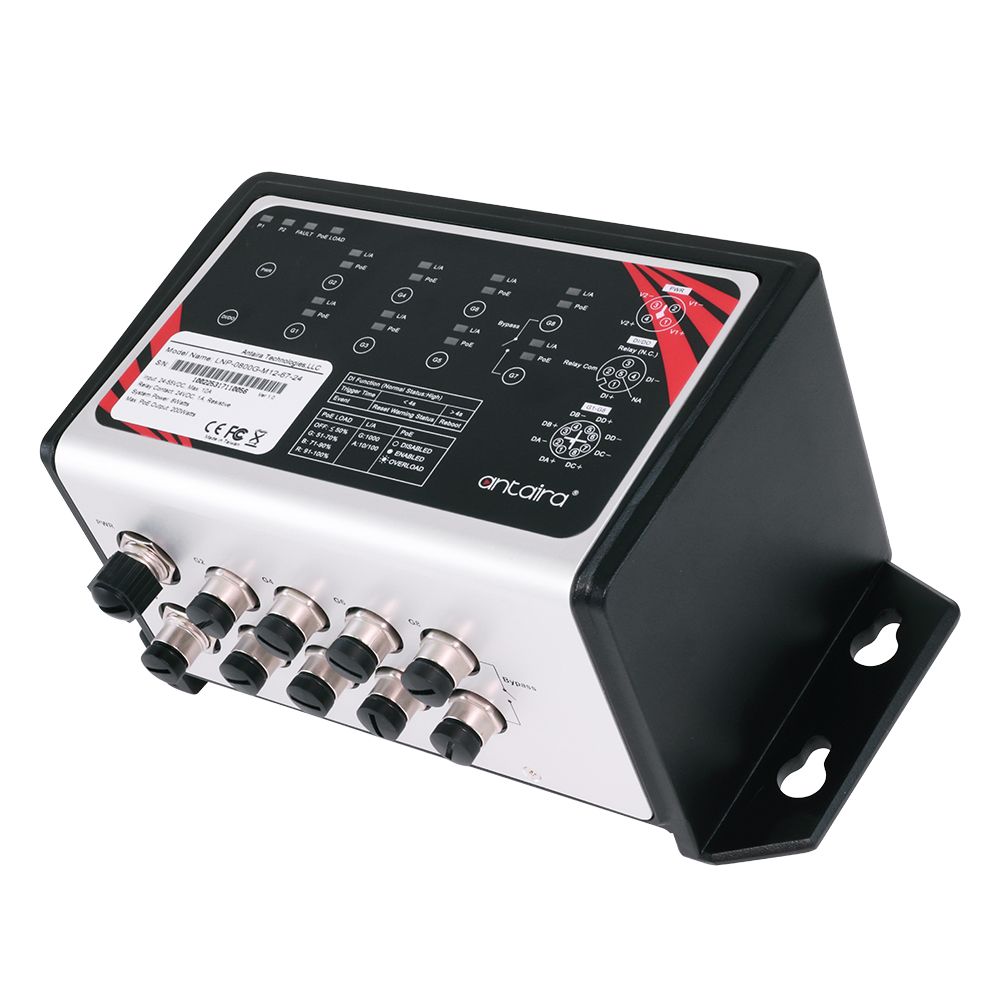
Article by Henry Martel, Field Application Engineer, Antaira Technologies
What is a PoE budget?
If you ask an accountant what a budget is, they’ll tell you it’s a spending plan based on how much money you earn versus what you spend over a certain period.
In industrial networking circles, budgets exist, too. Except instead of money, the currency is power. Let us explain: Industrial networks deploy PoE Ethernet Switches, PoE Injectors, and PoE Media Converters as Power Sourcing Equipment (PSE) to supply electricity to Powered Devices (PD) that the devices, in turn, “spend.” The ranks of PDs can include such devices as IP cameras, WAPs, VoIP, laptops, and sensors, among others. Total wattage required by the PDs that are connected to the PSE cannot exceed the maximum wattage supplied by the PSE. If power is insufficient, the PDs will not boot up or may be damaged. Low power is a common culprit in a PD powering “on” and “off” or reloading intermittently midway through a run.
This leads us to the concept of “PoE budget.” A PoE budget refers to the total amount of power the PSE can supply to its connected PDs. While PoE is measured by wattage, a miscalculation in developing a PoE budget will be measured by dollars in the form of unavailable or damaged devices, production downtime, or network outages.
PoE Types
How many watts can PoE provide?
Before we discuss PoE budgets, let’s briefly review the different IEEE standards for PoE:
- Type 1 (PoE): 802.3af supplies up to 15.4W per port to a PD that receives a minimum of 12.95W* over 2 pairs
- Type 2 (PoE+): 802.3at supplies up to 30W per port to a PD that receives a minimum of 25W* over 2 pairs
- Type 3 (PoE++): 802.3bt supplies up to 60W per port to a PD that receives a minimum of 51W* over 2 or 4 pairs
- Type 4 (“High Power PoE”): 802.3bt supplies up to 100W per port to a PD that receives a minimum of 71-90W* over 4 pairs
*The loss in output from what a PoE industrial switch injects into an Ethernet cable and the actual wattage that reaches the PD is due to a percentage of the power being converted to heat.
Note that there are industrial PoE switches that do not conform to IEEE standards. Non-standard PoE switches (“passive PoE switches”) will constantly supply power over Ethernet lines at a specific voltage regardless of whether the connected device supports PoE or not. If poorly matched, a passive switch will burn out a terminal device. Conversely, an IEEE compliant PoE switch will detect and classify a connected PD to verify if it’s within capacity before it powers the PD on, therefore preventing damage. To ensure safety and interoperability, only choose products that comply with the IEEE PoE standards.
So, the amount of power used by a PoE device can range from a few watts to 30 watts, depending on the device and the PoE standard used. It’s important to check the device’s specifications to determine its power requirements and ensure that the network switch or midspan injector can provide enough power.
Maximum Power Consumption
Just because a PD supports a PoE standard type, it doesn’t mean it will draw that type’s full power capacity. For instance, a wireless access point that supports IEEE 802.3af doesn’t necessarily require the full 15.4W; in fact, it may only need 5W. To know the WAP’s or any PD’s actual power requirements, you’ll need to check the manufacturer’s specifications for “Maximum Power Consumption.” If the Maximum Power Consumption for a PD is far less than a port’s full power capacity, the system administrator may want to configure the “Port Limit” to put a ceiling on how much power it can supply a PD.
You will use Maximum Power Consumption when calculating PoE Budget requirements. The math is simple: the Maximum Power Consumption of all the PDs that will populate a PoE switch are added, with the total wattage rounded up to act as a buffer. For example, let’s say your application calls for a PoE switch to supply power to four 9-megapixel 360° outdoor cameras. Each camera has a Maximum Power Consumption of 12.5W each. Therefore, the requirement side of the PoE ledger is 12.5W x 4 devices = 50W.
What is a total power budget?
A total power budget refers to the maximum amount of power that is available for use in a given system or application. This budget is typically defined by the power supply or energy source that is used to provide power to the system. The total power budget is the sum of the power consumption of all the components or devices within the system, including the processor, memory, storage, display, network interface, and other peripherals.
In electronic systems, the total power budget is an important consideration because exceeding the available power supply can cause the system to malfunction or fail. Designers of electronic systems must carefully balance the power requirements of each component to ensure that the total power budget is not exceeded.
How do you calculate PoE budget?
How do I know what is my PoE budget? How much power does PoE consume? Wattage?
Now, let’s assume you plan on using an 802.3af Ethernet 4-port switch that supplies 15.4W per port. Would this switch be appropriate for the camera application? The switch’s PoE budget is calculated by multiplying the number of ports by the wattage supplied per port. In this case, 15.4W x 4 ports = 61.6W. So yes, the switch will work. However, this still is cutting it close in the real world of industrial networks. For one, the actual wattage delivered to the camera over copper lines will be less than 15.4W (but not less than 12.95W).
So, you are still in the clear. However, network administrators often find it convenient to have at least one spare port for diagnostics, or several open ports to add more edge devices in the future. Also, PoE’s golden rule is that the more power your PSE has, the more power you can deliver per port. Therefore, choosing a higher power switch that can deliver total higher wattage reduces the chances of needing an upgrade later, as will selecting a switch with more ports.
Another caveat: It is rare for a PD to require its Maximum Power Consumption since this amount of power is only required when the device is operated at full capacity. Yet, if a PD needs less than the maximum wattage to operate, as is often the case, the PoE switch may still reserve the maximum amount of wattage based on the PoE class shown in the chart below based on its Class. If the PD supports PoE, but without classification, it is assumed to be class 0. For reference, see the below chart.

Another concern: A powered device can accidentally be overloaded by increasing its draw after an application is installed and a PoE Budget has been established. To give you a better idea, consider what would happen if a heater was added to the outdoor cameras mentioned above. A single camera heater can require up to 35W to operate, bringing the camera’s power requirements to 47.5W. This would badly deplete the 15.4W maximum power per port of your IEEE 802.3af four-port switch.

Finally, when planning PoE projects, factor in the environmental conditions where the PoE switch and PDs are installed. In an extremely hot or cold environment, you’ll need to plan for power delivery to be diminished by as much as forty percent of its power rating. That is, unless you choose an environmentally hardened industrial switch such as the Antaira LNP-0800G-M12-67-24-T. It is engineered to operate in a temperature range of -40° C to 70° C, unlike a non-hardened switch, to ensure the highest power delivery.

Antaira Technologies is a leading developer and manufacturer that provides high-quality industrial networking and communication product solutions. Their product lines range from industrial Ethernet switches, industrial wireless devices, Ethernet media converters, and serial communication devices. visit: antaira.com
See more articles on : Antaira Technologies
Source: antaira.com
Source: antaira.com

